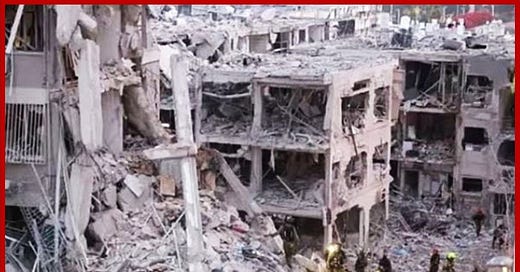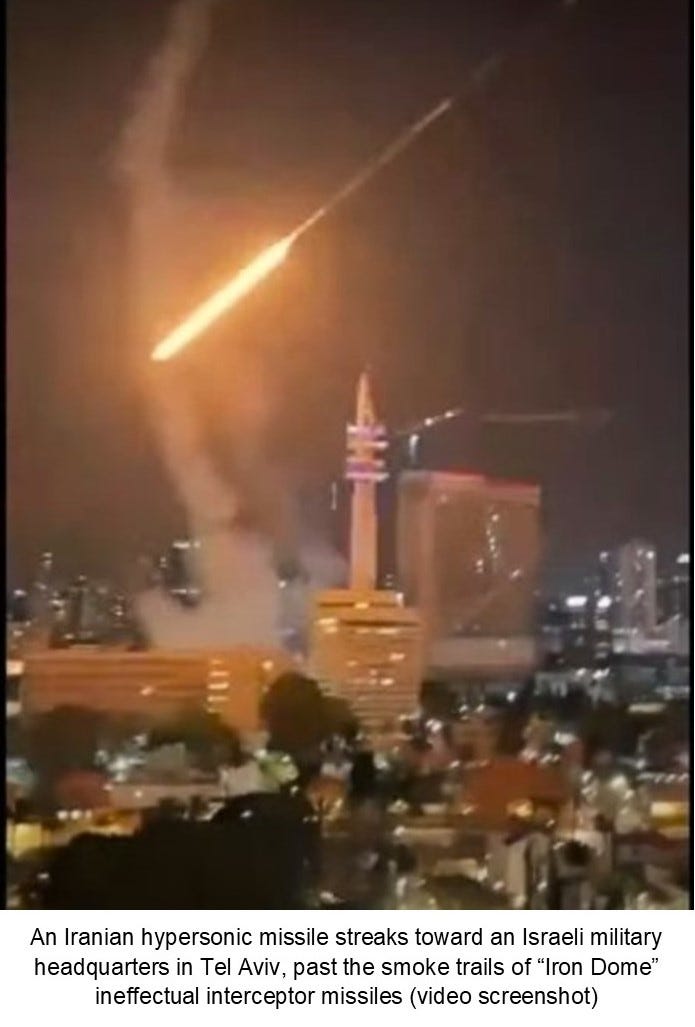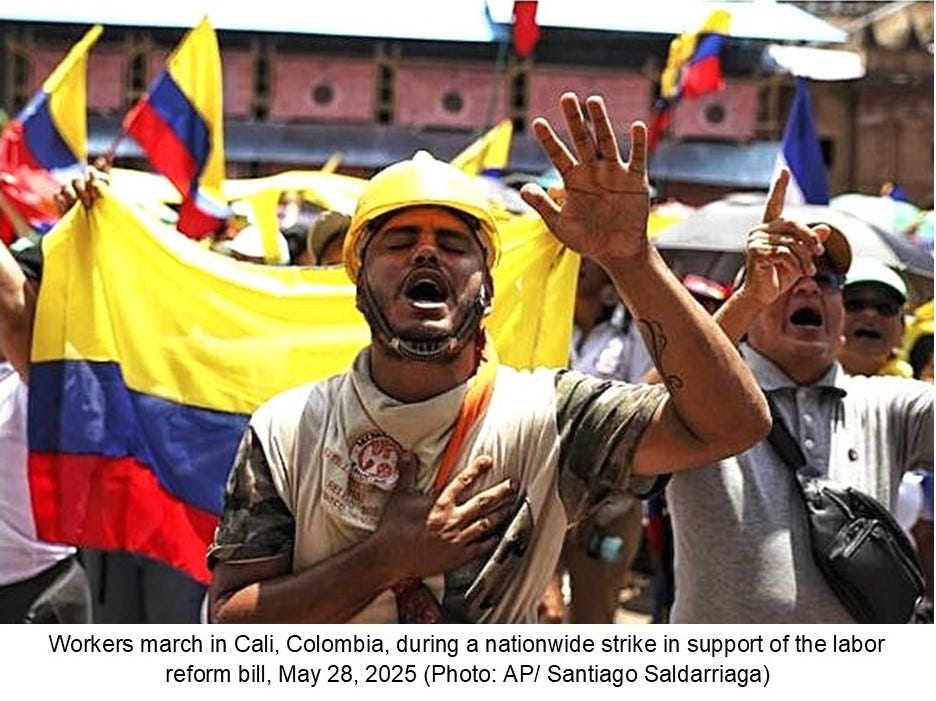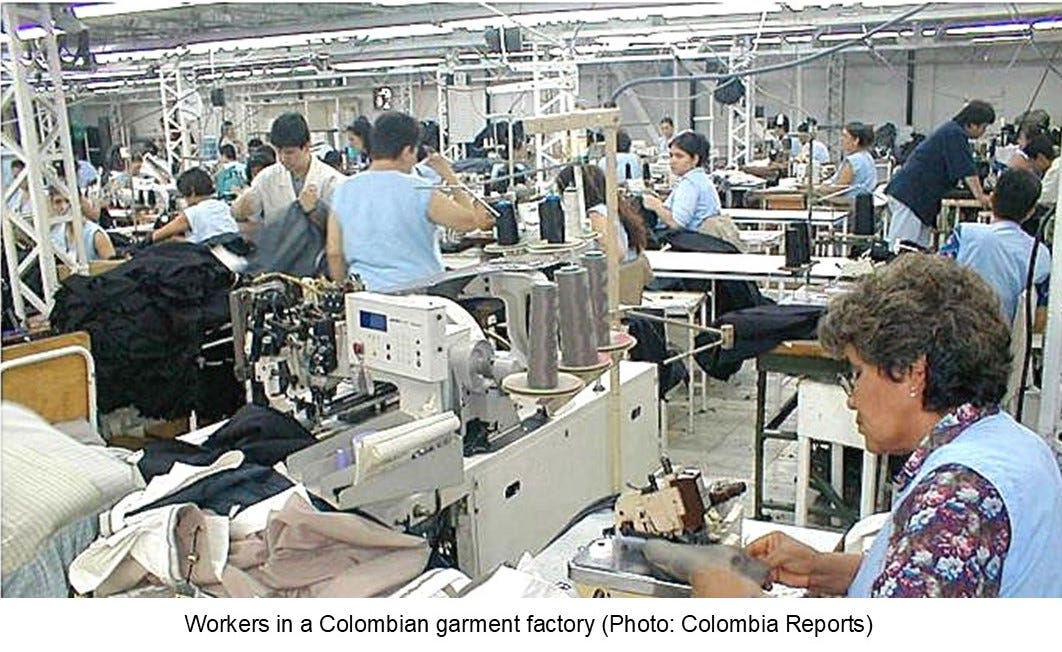Fallout: What's next in the aftermath of the US/Israel-Iran "nuclear" war?
Plus: Workers score in the Colombian class war
Was the 12-day war launched by Israel and the US against Iran really about nuclear weapons? Yes and no. Israel’s main objective was “regime change” in Iran. We’re not talking about a makeover in which Iran would be transformed from a parliamentary theocracy into a Western-style “democracy” (like Israel?!). Not at all. Their goal was to make Iran into a totally fragmented and non-functional state, like Libya is, or Syria was (and to a large extent still is). That is to say, a place Israel can bomb or occupy or otherwise exploit at will, supporting this or that militia to divide and conquer, with never a fear of any consequences. The United States’ “National Security” Deep State has had the same goal, practically speaking, since the Iranian revolution of 1979 that overthrew the shah.
Israel pitched its blitzkrieg regime-change plan to Washington and the Trump gang eventually bought into it, undoubtedly under pressure from the Deep State and the Israel lobby, with which both Trump and his cronies and the Deep State are closely linked anyhow. The plan was aided by Trump’s ongoing “negotiations” with Iran. Whatever their original purpose may have been, they became a ruse to put the Iranians off guard. Let us not forget that during his first term it was Trump who pulled out of the nuclear agreement with Iran negotiated under Obama.
The anti-Iran plotters were aided also by the IAEA (International Atomic Energy Agency), which conveniently issued a report criticizing Iran the day before the Zionists’ attack. As we now know, the IAEA was infiltrated by the Mossad, Israel’s intelligence agency. And of course, the IAEA report, which had nothing to do with a nuclear weapons program, furnished Israel with a phony pretext for its attack.
Trump gives the green light
So, Trump gave Netanyahu the green light. But after Israel’s initial tactical successes in assassinating Iranian military leaders and scientists, along with the family members of those who were at home at the time (assassination being Israel’s specialty), it became clear that the plan was not succeeding. The Mossad agents pre-positioned in the country to create chaos by setting off car bombs and such, were quickly rounded up by Iranian security forces. Opponents of the Iranian government did not come out to rally in support of Israel’s attacks or to demand that the Iranian government pack its bags. On the contrary, the attacks galvanized support for the government to a degree not seen in decades.
“What the United States and what the Israeli regime have done is that they’ve united Iranians in a way which I have never seen since the 1980s when Saddam Hussein invaded the country. And I don’t see how Iran will ever be able to have any deal with the United States under the current [US] regime.” — Mohammad Marandi, Iranian-American political analyst and professor at Tehran University on the Katie Halper Show.
Even more important, within a few hours the Iranian army and Revolutionary Guard Corps had filled the places of the assassinated commanders and begun their counterattacks.
The Zionists were not expecting a lot of damage. They had their much-vaunted, multi-tiered aerial defense system. And on the few past occasions when Iran has retaliated for an Israeli attack there was more inconvenience to Israel from the large numbers of people having to shelter in air-raid bunkers than there was damage from any incoming missiles or drones that penetrated the air defenses.
The Zionists’ miscalculation
But Israel had badly miscalculated. This time was different. First there was the sheer volume of Iranian projectiles. The nearly constant Iranian attacks involved hundreds of missiles and drones. Many were older weapons that were likely being used as decoys to distract, confuse, or overwhelm Israel’s aircraft defenses. They came at any and all hours of the day and night. But the real Iranian weapons were ones that hadn’t been seen before — hypersonic missiles with new highly-accurate guidance systems. These weapons had never been used before in combat. Israel always claims that its aerial defenses destroy the majority of incoming missiles and drones, but we saw no evidence that it was able to down any of these new Iranian hypersonic missiles. Even though Israel tried to censor all information about the attacks, mobile phone videos shot from high-rise balconies appeared on social media. Some recorded interceptions of the older projectiles, but the hypersonic missiles streaked right past the interceptors and hit their targets.
On target
Clearly, the Iranians had mapped Israel’s military and intelligence targets, as well as strategic infrastructure. They inflicted terrible damage. They shut down the port of Haifa and the Bazan oil refinery, Israel’s largest. They hit military and intelligence facilities in Tel Aviv, Beersheba, and elsewhere. Photos that made it past the censors showed entire city blocks with their buildings gutted from a single Iranian missile. Only the targeted building was collapsed; the rest, for perhaps 100 meters in all directions, were left as structural skeletons with all their windows and doors blown in. Now, more than a week after the war was paused, some of the truth is beginning to seep out in the Israeli media. At least one major outlet commented on the unusual force of the blasts from the new Iranian missiles. A July 6 report in The Times of Israel said five IDF bases were hit by Iranian missiles.
Another Israeli source says an “initial estimate” put Israel’s losses from the 12-day war at US $20 billion. But the worst damage is at this time intangible. That is the damage to Israel’s image. For foreign economic partners, present or potential, Israel can no longer viewed as secure, dependable, or in control of the situation in the Middle East.
We said “yes and no” to the question of whether the war was about nuclear weapons. Nuclear weapons, we said, was a pretext for an attempt by Israel and the US at “regime change.” That attempt failed. As far as the question of Iran developing a nuclear weapon is concerned, the war backfired. Iran says it has withdrawn from the IAEA, and will no longer grant it access to Iranian nuclear facilities, and that is exactly what it should have done. Moreover, sectors in Iran are now pressing for withdrawal of the fatwa against development of nuclear weapons.
The Samson Option
The Samson Option refers to an Israeli doctrine that the Zionist entity would use nuclear weapons in the event occupied Palestine was in danger of being “overrun” in a war. Although Israel doesn’t comment on its possession of nuclear weapons, there is a mountain of evidence that they do have them (estimates run from 90 to 200 warheads and more). “The Samson Option” is the title of a 1991 book by Seymour Hersh about Israel’s nuclear weapons program. Israel is not a signatory to the Nuclear Nonproliferation Treaty.
The Zionists have good reason to fear a nuclear-armed Iran. It would cancel out the Samson Option. It would mean that Iran had chosen the North Korean Option. North Korea’s development and possession of nuclear weapons has taken “regime change” off the table as a realizable goal for that country’s enemies.
To prevent the conflict from getting out of hand, Iran has in the past followed a policy of carefully calibrated responses to Israeli attacks. But that hasn’t worked. During the 12-day War, the destruction wreaked on Israel by Iran’s new hypersonic missiles, forced Trump and Netanyahu to call it quits — for the moment. But to defend itself and its people, Iran must continue strengthening its defenses and its deterrence capabilities.
According to Mohammad Eslami and Ibrahim al-Marashi, writing in Middle East Eye, Iran is making use of the pause in the war to upgrade and expand its defensive capabilities, seeking to modernize its air force and air defense systems, including the addition of an airborne early warning system.
Taking them to court
On the political/diplomatic/legal front, Iran is also preparing to submit a complaint to the International Court of Justice, charging Israel and the US with initiating an undeclared war and violating Iranian sovereignty by attacking nuclear facilities protected by international law. Until this legal process runs its course, the Iranians assert, they will not return to the nuclear negotiation table.
Iran has also declared that it will not abandon its peaceful nuclear energy program. That is its right as a sovereign nation.
Meanwhile, the Palestinian Resistance fights on. And in Lebanon, Hezbollah declared this past week that they will not disarm, at least not until all Israeli troops are out of Lebanon. This came in defiance of a demand by the US and Israel. So things may be heating up again on Israel’s northern border.
Colombia: The labor reform victory was won in the streets, not in Congress!
[The president of Colombia, Gustavo Petro, was elected as the candidate of a “popular front” called the “Pacto Histórico,” or “historic pact.” A popular front is a multiclass coalition of reformist social-democratic and liberal capitalist parties. Just a few weeks ago, a broad labor reform bill, the cornerstone of Petro’s election campaign platform, had been stalled — tabled or “shelved” — in the Colombian Congress. It had been there since shortly after Petro’s 2022 inauguration.
The “cabildos,” referred to below, sometimes called “cabildos abiertos” or “open councils,” are an institution that dates from colonial times, much like the New England town meetings of the colonial era in North America. During the Spanish colonial era, participation was limited to pure-blooded Spaniards of the upper classes. In recent years, however, the cabildos have become vehicles for mobilizing the workers and campesinos.
The gains for the Colombian toilers from this legislation are significant, especially because — as the author notes — they come not as a result of politicking in the Colombian Congress, but through the mass action of the toilers themselves. In recent years the Colombian workers have shown time and again that they are ready to take to the streets. — RO]
By Gabriel Galeano
After two months, including three days of general strikes, President Gustavo Petro's labor reform has been officially approved by the Congress, despite being shelved initially in a maneuver that unleashed the fury of the working class across the country.
As approved, the labor reform includes most of the provisions included in a referendum that had been planned in the event the reform failed to pass Congress: Sunday and holiday premiums of up to 100% beginning in 2027 (with progressive increases in the intervening years), night-shift bonus pay of 35% starting at 7 PM, ratification of contracts by default in an attempt to provide job stability, and payment of the minimum wage to SENA (National Apprenticeship Service) workers during their practical training phase, among others.
Passage of the reform is a real victory for the Colombian working class. Since the time of the Álvaro Uribe government, which had declared that Colombia was being killed by laziness, the workers have suffered decades of worsening living conditions.
It is important to understand, however, that Colombian capitalism is not producing enough wealth to implement such reforms within the limits of capitalism (i.e., generating sufficient profits for business owners while maintaining the flow of foreign capital into the country). Hence the whining from business associations — the talk about how many jobs will be lost due to the reform and the possible bankruptcy of small businesses.
The Colombian economy, despite its growth, is clearly colliding with the limits of international capitalism. Hence the need to break the fiscal rule. In order to maintain the 3% growth rate the government needs to continue with a program of social reforms and maintain an unemployment rate of 8.8%. Eventually, this limitation will mean that employers will have to cut wages and social services to recover their profits.
In a country where the minimum monthly wage is US$397.70 while the per person cost-of-living averages US$759.39, it isn’t surprising that the labor reform became the greatest challenge for Petro's program, both for workers and for the ruling class, which relies heavily on low wages to attract foreign investment.
In the end, the Senate approved the reform in large part to stave off the referendum. A referendum would have entailed continuation of the mass mobilizations for months to come. Had it not been for the pressure of the demonstrations and the threat of a referendum, the senators would have had no reason to revive the reform. In the end they approved 66 of the 70 original articles, despite trying to soften them to please the business owners, who on their side exerted enormous pressure to avoid the referendum.
The oligarchy’s fear of a general strike and the role of the reformists
The nationwide mobilizations that began on March 18 drew hundreds of thousands of workers to the main cities. May 1st was a turning point, with one of the largest demonstrations in Colombia’s history. Especially worth noting is the role the cabildos played in organizing the demonstrations. On several occasions, the barrio organizations used them to get around the passivity of the union leadership.
Passage of the reform will for a time strengthen Petro's political authority on the left. But what the results really show is the weakness of both the oligarchy and the reformists.
On the one hand, due to its fear of a popular referendum, the oligarchy had to concede to the government on most aspects of the reform. On the other hand, the reformists deliberately tried to avoid open-ended mobilizations in order to keep the movement within the framework of parliamentary democracy. Essentially, the Pacto Histórico had no problem using scattered rallying points, scheduling marches for widely separated dates, and trying to ensure that the cabildo meetings were controlled by the old union leaders to prevent the movement from getting out of hand.
The oligarchy’s fear of a general strike is the dominant factor in Colombia’s political life. It feared mass mobilization around the reform precisely because it feared a general strike. That is why the threat of a popular referendum made the business community shudder, even with the mobilizations curtailed.
How will the ruling class respond?
Very few concessions were made to the ruling class in order to pass the labor reform. The most important occurred a year ago when the House of Representatives approved it. At that time the articles protecting the right to unionize and strike were dropped. The elimination of those articles hinders the organization of the working class in a country where only 4% of the workers are unionized.
Indeed, that concession helps the Colombian oligarchy sleep more peacefully. The country's largest companies depend on their ties to the global market, which in turn relies largely on the rate of exploitation of the Colombian working class, whose labor productivity is US $20.50 per hour and whose minimum hourly wage is US $1.89 per hour.
The working class receives only 10% of the value it produces for society. The workers must demand much more. The reality is that none of the companies in Colombia could exist without the labor of the working class. If companies that claim to exist for the good of society cannot pay enough to sustain the lives of the workers who make these companies possible, they must open their books and show clearly that they can’t pay a living wage. And if that is the case, they should be nationalized and placed under the workers’ control.
The Need for Unionization
The victory in the labor reform battle will improve the quality of life for the working class. But the only way to make it truly worth the effort is to prepare the ground for further progress in the future. To achieve this, we must take stock of what has been accomplished and what still needs to be done.
The gains in Sunday and night-shift pay, as well as the other aspects of the reform, were won through the mobilization of the working class, not as gifts from above. Sooner or later, the capitalists will have to go on the offensive to recover the losses to their profits from the wage increases. They will not sit idly by with their arms folded. And the only way to defend the gains is by class organization in unions and labor federations. That will enable workers to organize strikes and extend the struggle to every workplace. Implementation and defense of the reform requires that the leadership of the working class oversee the workers’ organizations and ensure that every workplace honors the terms of the reform.
The way to achieve working-class control over capitalist enterprises is through the workers’ organizations — the unions — which would allow the working class to generalize the struggle by uniting the struggles of every factory in each sector. The working class must expand its class organization to every workplace, every point of production. Only on that basis can it effectively fight for its rights. Without organization, as Marx explained, the working class is merely raw material to be exploited. But organized and aligned in combat formation, the workers can defeat the bosses. Because it it they themselves who produce all the capitalists’ wealth.
The struggle continues! Ever onward to victory!
[This article was adapted and translated from colombiamarxista.com. Where will the leadership come from that the author speaks of? It won’t come from the existing trade union bureaucracy. Nor will it come from the spontaneous rebellions of the workers themselves, by and large, no matter how combative the workers may be. It can only come from a mass workers’ party of the Bolshevik type. It must be a revolutionary vanguard party, steeled in the workers’ struggles, a party that points the way to a workers’ and campesinos’ government, which well may prove to have its foundation upon Colombia’s cabildos.]












